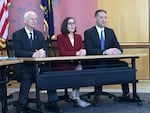After years of struggling to figure out what to do with the Elliott State Forest, Oregon officials now have a proposal they like. Members of the State Land Board voted Tuesday to start work on a plan to transfer the 80,000-acre forest near Coos Bay to Oregon State University.
The university’s idea is to create the “Elliott State Research Forest.”
OSU President Ed Ray told Land Board members that the university’s “unmatched” experts would be available to assist with the Elliott regardless of who was tapped to own the forest.
“The question is, Do you want to stop there, or do you want to go further?” Ray added. “Do you want or do you aspire for Oregon, the nation and the world to have a leading research capability that helps all of us understand around this globe how to manage forest resources going forward?”
The plan would include a mix of uses on the forest including, Ray said, "active management." Other uses would reflect public values identified by the Land Board, like recreation, public access and conservation.
“We envision this being the source of critical information that we use to inform conservation management now and as we work through the ongoing changes driven by our climate,” OSU Interim Forestry Dean Anthony Davis told the board.

The Elliott State Forest
Oregon Department of Forestry
It would be one of the largest forests devoted to experimentation and research in the United States and the size advantage would allow scientists to ask questions that couldn't be answered on smaller tracts of land.
“They see a strong research component that will inform the future of not only timber management, but of climate change adaptation and response,” said Oregon Treasurer Tobias Read, who voiced enthusiastic support for the OSU plan. “[There would be] significant potential for tribal partnerships and of course, support for rural communities.”
Gov. Kate Brown also voiced support for the research forest proposal.
“I do think we can move forward on this path and keep the forest for the benefit of Oregon school children. Probably in a different way — maybe less of a financial resource, and more of an educational resource for the next seven generations,” Brown said.“This would be a unique opportunity for Oregon to lead the nation, if not the entire world."
The state has been considering what to do with the Elliott State Forest for years. It started when endangered species court rulings limited logging and the forest stopped generating money, as required, for Oregon schools through the Common School Fund.

Oregon Secretary of State Dennis Richardson, left, Gov. Kate Brown, and Oregon Treasurer Tobias Read make up Oregon's State Land Board.
Cassandra Profita / OPB
Most recently the land board, comprised of Read, Brown and Secretary of State Dennis Richardson, asked for proposals that would keep the forest in public ownership.
Several other entities had expressed interest in the forest, including two local counties, two tribes, the Oregon Department of Forestry and a nonprofit Christian ministry group.
Last year, the Legislature approved $100 million in bonds to hold the school fund over while a new forest owner could be found. And on Tuesday, the Land Board approved a declaration allowing the bonding to move forward.
But an additional $121 million is needed to compensate the Common School Fund for the appraised value of the Elliott State Forest.
As with every applicant, OSU’s path to finding the necessary $121 million is deeply uncertain. The university “can’t foresee circumstances in which the university could purchase the forest outright,” Ray told the Land Board.
Part of that uncertainty, he noted, comes from the two-year budget Brown proposed earlier this month. The proposal would hold funding for state universities flat — effectively creating a budget cut as higher education costs rise. The governor has promised funding increases to universities if state lawmakers are able to find some $2 billion in new funding for her education priorities.
“Under the currently proposed budget, OSU faces a funding challenge of budget reductions of perhaps $20 million of operating funds,” Ray said, noting that the university was unwilling to borrow against “forest harvesting that cannot be sustained, or add more controversy to the university.”
That left a question of where funding might come from — something that will have to be answered in months to come.
Both Ray and Read expressed a desire for details of the plan to be worked out by the end of 2019.